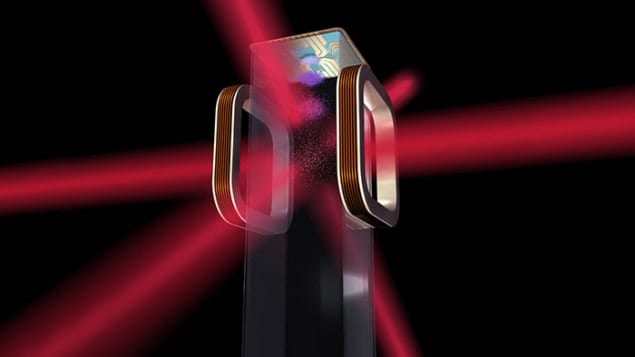NASA to launch Cold Atom Lab in space
A laboratory for cooling an atomic gas to just a billionth of a degree above absolute zero will soon be sent up to the International Space Station (ISS) by physicists working at NASA’s Jet Propulsion Laboratory. The goal of the Cold Atom Lab (CAL) mission is to create long-lived Bose–Einstein condensates (BECs) that could lead to better sensors and atomic clocks for use on spacecraft. The BECs could even provide important insights into the nature of dark energy, according to the researchers.
First created in 1995, a BEC is made by trapping and cooling an atomic gas to an extremely low temperature so the atoms fall into the same low-energy quantum state. Instead of behaving like a collection of individual atoms, a BEC is essentially a large quantum object. This makes it very sensitive to disturbances such as stray magnetic fields and accelerations, and therefore BECs can be used to create extremely good sensors.
Falling down
Here on Earth, gravity puts an upper limit on the lifetime of a BEC – the atoms fall down and after a fraction of a second the BEC has dropped out of view of the experiment. In the microgravity environment of the ISS, however, NASA’s Robert Thompson and colleaguesreckon that their BECs should be observable for 5–10 s. As well as allowing physicists to make more precise measurements of the quantum properties of BECs, the longer lifetime should also make the BECs better sensors. With further development, the team believes that BECs in space could endure for hundreds of seconds.
Five scientific teams will do experiments using Cold Atom Lab, including one led by Eric Cornell of the University of Colorado – who shared the 2001 Nobel Prize for Physics for creating the first BECs.
As well as creating BECs, CAL will also cool fermionic atoms to create degenerate Fermi gases. These systems can be made to mimic the behaviour of electrons in solids and could provide important insights into phenomena such as superconductivity. Physicists will also study ultracold mixtures of bosonic and fermionic atoms. Other planned experiments include atom interferometry and very precise measurements of gravity itself.
Pervasive forces
“Studying these hyper-cold atoms could reshape our understanding of matter and the fundamental nature of gravity,” says Thompson. “The experiments we’ll do with the Cold Atom Lab will give us insight into gravity and dark energy – some of the most pervasive forces in the universe.”
CAL will be contained within a package about the size of an “ice box”. This will contain a vacuum chamber, lasers and electronics. It will also include an electromagnetic “knife”, which will be used to cool the atoms. The lab is currently in the final stages of assembly and will be launched in August on a SpaceX CRS-12 rocket.
1/9/2018 from physicsworld.com

Δεν υπάρχουν σχόλια:
Δημοσίευση σχολίου